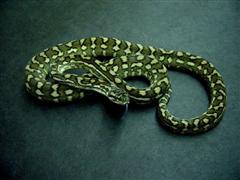Python - Carpet
Morelia spilota
Sat, 19th April, 2025 - 5:28 am GMT
Sponsor Ads:

Alternative Name
Morelia spilotaBasic Info
There are several varieties of Carpet Python that range between 6.5 and 12 ft (2-3.6 meters). The average length is eight feet. While different in coloration, all of the varieties have a rich pattern of markings on the dorsal surface. The smallest subspecies is the Diamond Python, which is very dark brown with small, pale blotches edged in black. The imbricata variety, from southwestern Australia, is olive green with yellow-gray patches edged in black. These patches are long and connected. Variegata, a subspecies from the Top End and the Kimberly, are dark brown with yellow blotches forming bands around the body. Mcdowelli, which lives on the eastern coast, is varying shades of brown with moderately sized, pale blotches edged in black. The side has a line of paler patches. Cheynei is the variety of Carpet Python that dwells in the wet areas of northeastern Queensland. This variety is very dark brown with yellow-gray or yellow-green markings that cover much of the body.
Health
Breeding Breeding behavior begins in early spring, when males begin to fight each other for the right to mate. The victor mates with the female, who then ceases to eat and spends most of her time basking with her belly exposed to the sun. Between November and January (summer in the Southern Hemisphere), the female gives birth to a clutch of between 7 and 54 eggs. The average clutch is between 12 and 23 eggs. After laying the eggs, the female coils her body around the eggs, providing them with a small amount of warmth. If the temperature drops slightly, the female will twitch her body, which provides a little extra warmth to the eggs. If the temperature drops significantly, the female will stop vibrating. The decreased temperature, though, does not harm the embryos. When the weather is nice, the female will often leave the nest to bask. The eggs hatch after between 37 to 103 days of incubation, usually between January and February in the wild. The hatchlings, which are about 30cm at birth, usually stay in their eggs for about twelve hours after pipping. The incubation temperature can affect the sex of the young.Habitat
They live everywhere from the rainforests of the coast to the arid deserts in the center of the continent. They also live on rocky hills and in ravines. Carpet Pythons are often found near water, especially where there are trees, but not always.Behavior
The Carpet Python is a moderately sized Python native to Australia and New Guinea. They are a threatened species and, while sometimes captured for the pet trade, the snakes are more often used for their skins. Carpet Pythons and other large snakes are an essential part of the global family and are very important to humans. Carpet Pythons often dwell in piles of leaves, hollow trees or logs, amid rocks, or in caves.There are at least seven subspecies of Carpet Python, all of which interbreed. During the hot summer months, Carpet Pythons are nocturnal, meaning they are active at night. When the weather is cooler, however, they are diurnal, which means active during the day. The name "Carpet Python" comes from the markings on the various varieties of the snakes, which many people feel resembles an oriental carpet. Many Carpet Pythons dwell in abandoned burrows of other animals.Origin
Australia and New GuineaHistory
An adaptable animal, the Carpet Python makes its home in a variety of different types of habitats throughout New Guinea and all of Australia, except the western and southeastern areas. Metcalfei dwells in the drainage system of eastern and southeastern Australia and is reddish-brown with pale, black-edged spots that are usually divided into two sections.Common Foods
Carpet Pythons feed primarily on vertebrates, especially birds, marsupials, and rodents.Sponsor Ads:
Programming, is like sex. Make one mistake, and you support it for the rest of your life.
Python - Carpet
Coded by: BGID® | ALL RIGHTS RESERVED Copyright © 2000-2025
Disclaimer | Privacy | Report Errors / Contact | Credits
















